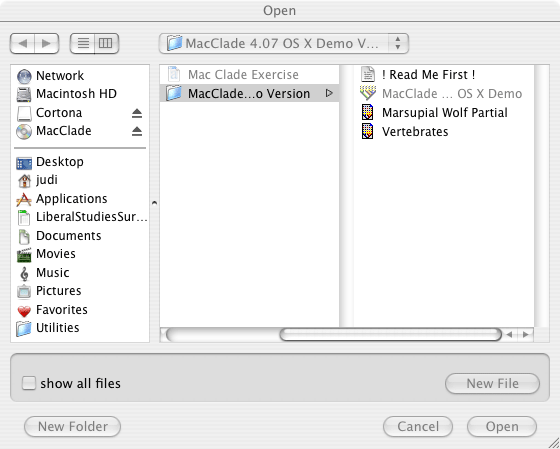
| Geology 105 - Paleontology | ||||||
| Course Syllabus | Course Schedule | Assignments | Course Handouts | Critter Charts | Department Home Page | Kusnick Home Page |
1. Open MacClade by clicking on the
tree icon in your dock. You should see a dialog box. Click on Vertebrates.

2. This opens a tree window for selected vertebrates. The initial tree is simply random – do not read it as a hypothesis about evolutionary relationships. You will construct your own hypotheses.
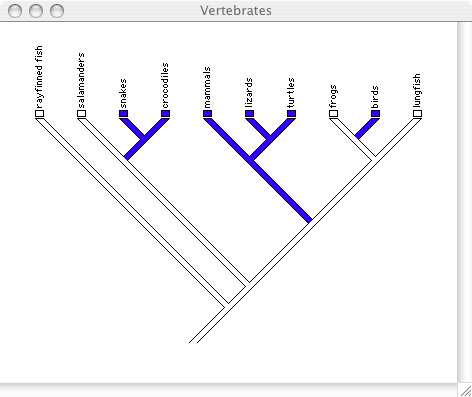
3. To see the data for this tree, go to the Windows menu and and click on Data
Editor.
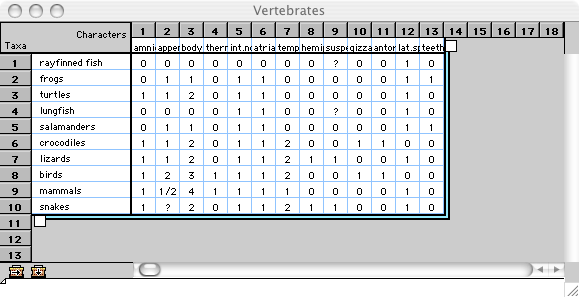
For a more complete list of characters, go to the Character Menu and click on Character List.
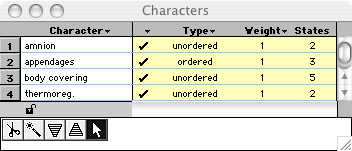
Go back to the Character Menu and click on State Names & Symbols.
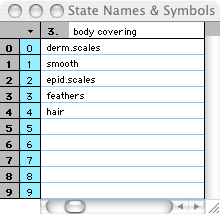
These windows together tell you the characters in the analysis, and what the various states of that character are. For example, character #3 is body covering. There are 5 different states of this character. 0 stands for dermal scales, 1 for smooth, 2 for epidermal scales, and so on. Choose a taxon from the Data Editor and look up all its characters and character states.
4. Now use the Windows Menu to go back to the Tree Window.

Notice that part of the tree is blue and part white. In the bottom corner of the Tree Window is a small Character State window.

Right now it should say “amnion.” The key shows us that the blue means the taxon has an amnion (egg covering) and the white taxa do not. Use the scroll bar at the bottom of the window to flip through the characters.
5. The tree is your hypothesis about evolutionary relationships among these
groups. The current tree is a bad guess, as the small window in the corner tells
you.

The treelength is quite long (35), and as you flip through the characters you will see that similar colors are not connected. Now we’ll change the hypothesis.
6. Scroll the Character window back to “amnion”. Right now your
tree indicates a hypothesis that the amniotic egg independently evolved in three
different lineages – not a very likely scenario. By clicking and dragging,
move the branches of the tree to get all the blue taxa together on the right
side of the tree and the white taxa together on the left side. Now you have
formed the hypothesis that the amniotic egg formed only once. However, there
are other characters to consider.
7. In the Character window, click over to appendages.

You may find taxa with fins (white) mixed up with taxa with legs (blue). Rearrange your tree to form the hypothesis that legs evolved only once. Once you think you are done, click back to amnion to be sure that you haven’t disturbed that hypothesis. If you have, move taxa around until it works for both amnion and appendages. Don’t worry about birds – as long as they are the only taxon coming off a lineage with legs, you still have a consistent hypothesis.
8. Work through all the rest of the characters. Are you able to construct a
tree that works for all the characters? What happens to your treelength as you
edit the tree?
9. Once
you have gone through all the characters once, go back through them and
edit your tree until you find a tree that makes the most evolutionary sense (similr
character states cluster together) for the most characters. You
will need to flip back and forth between the characters to do
this. You will NOT be able to construct a tree that works
perfectly for all the characters.
10. On a separate piece of paper, answer these questions:
10. Take a
screen capture of your final tree (it doesn't matter what character the
tree is displaying). Press command (apple)-shift-3. You
should hear a little sound like a camera clicking. Hide your
MacClade window by clicking Command (apple)-H. You should see a
new PDF file on the desktop named Picture 1. Click
on the name Picture 1 (not the icon), and it should switch to an
editable field. Rename the PDF document with the last names of
your group and leave it on the desktop. I will collect them from
the computer later.